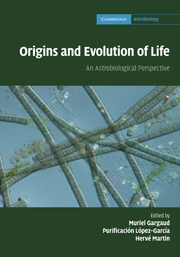Book contents
- Frontmatter
- Contents
- List of contributors
- Foreword
- Preface
- Part I What is life?
- 1 Problems raised by a definition of life
- 2 Some remarks about uses of cosmological anthropic ‘principles’
- 3 Minimal cell: the biologist's point of view
- 4 Minimal cell: the computer scientist's point of view
- 5 Origins of life: computing and simulation approaches
- Part II Astronomical and geophysical context of the emergence of life
- Part III The role of water in the emergence of life
- Part IV From non-living systems to life
- Part V Mechanisms for life evolution
- Part VI Life in extreme conditions
- Part VII Traces of life and biosignatures
- Part VIII Life elsewhere?
- Index
1 - Problems raised by a definition of life
from Part I - What is life?
Published online by Cambridge University Press: 04 February 2011
- Frontmatter
- Contents
- List of contributors
- Foreword
- Preface
- Part I What is life?
- 1 Problems raised by a definition of life
- 2 Some remarks about uses of cosmological anthropic ‘principles’
- 3 Minimal cell: the biologist's point of view
- 4 Minimal cell: the computer scientist's point of view
- 5 Origins of life: computing and simulation approaches
- Part II Astronomical and geophysical context of the emergence of life
- Part III The role of water in the emergence of life
- Part IV From non-living systems to life
- Part V Mechanisms for life evolution
- Part VI Life in extreme conditions
- Part VII Traces of life and biosignatures
- Part VIII Life elsewhere?
- Index
Summary
Introduction
Looking for a definition of life raises various issues, the first being its legitimacy. Does seeking such a definition make sense, in particular to scientists? I will successively refute the different arguments of those who consider that looking for such a definition makes no sense, and then propose good reasons to do just that, but also add some caveats regarding what sort of definition is sought. After considering definitions proposed in the past, I will examine various present-day definitions, what they share and how they differ. I will show that the recent suggestion that viruses are alive makes no sense and obscures discussions about life. Finally, I will emphasize two important recent transformations in the way life is defined.
Philosophical and scientific legitimacy of a definition of life
Two questions immediately emerge. Are we seeking a definition of life or a definition of organisms? And what kind of definition should be sought? Two types of definition are, in fact, traditionally distinguished. A definition may aim to give the essential characteristics that causally explain the existence of the category of objects considered. Or a definition may be of more limited scope: to establish a list of properties that are necessary and sufficient to define this category of objects and to distinguish them from objects belonging to other categories. If one adopts the first kind of definition it will be possible to define life. If one opts for the second, one will look for a definition of organisms.
- Type
- Chapter
- Information
- Origins and Evolution of LifeAn Astrobiological Perspective, pp. 3 - 13Publisher: Cambridge University PressPrint publication year: 2011

